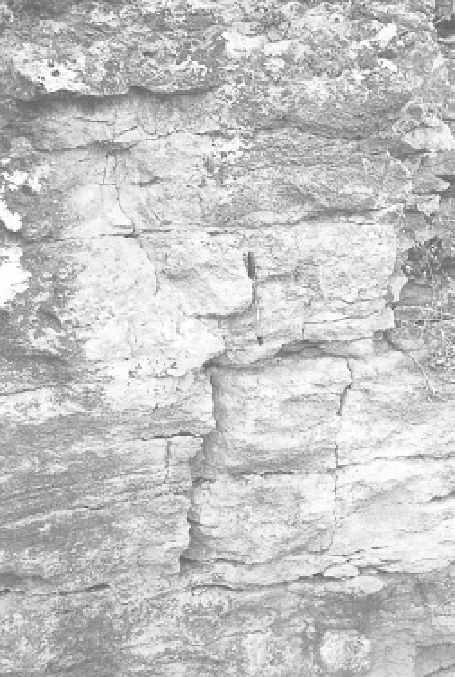Agriculture Reference
In-Depth Information
Fractured rock of Middle Jurassic
limestone underlying Grand
Cru vineyards near Gevrey-
Chambertin, Côte d'Or (scale 15
cm). Photograph by the author.
See color insert.
Figure 9.7
has eroded away. Over the years, the vignerons have carried eroded sediment from
the lower slopes back to the upper slopes.
The most favored areas are at the midslope, where the gradient is 3-5%, ris-
ing in places to 20%, and the soils are stony (5-40% gravel-size fragments). Al-
though the Rendzinas and Calcareous Brown Soils on limestone are generally
1 m
deep, the vine roots can penetrate more deeply through fissures in the fractured
rock below, as shown in figure 9.7. The limestone provides a regulated supply of
water when the vines come under stress in late summer, in a way similar to that
described for the vines on limestone in St. Emilion (section 9.3.2). Wines of lesser
quality are produced on the upper escarpment—the Hautes Côtes—and on the
lower slopes where the soils formed on colluvial limestone and marl are deeper,
less well drained, and higher in nutrients.
Both red and white grape varieties are grown in the southern part of the Côte
d'Or—the Côte de Beaune—but the most favored variety is Chardonnay. It grows
best on the crumbly marl and limestone-derived soils, especially in the communes
of Puligny-Montrachet and Chassagne-Montrachet.
Mâconnais
. This subregion, of lesser distinction than the Côte d'Or to the
north and Beaujolais to the south, has two main terrains:
• Sandstones and other siliceous deposits, supporting Leached Brown Soils of
pH 5-6. The main grape variety grown on these soils is Gamay, which
generally produces wines of “grand ordinaire” quality.

